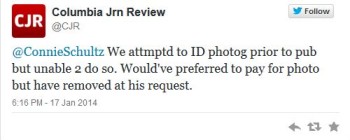
Illustration by London Shearer Allen
Columbia Journalism Review unpublished a photograph after a Cleveland Plain Dealer photo editor complained of copyright violation.
According to the blog Hell and High Water: The Battle to Save the Daily New Orleans Times Picayune, the Columbia Journalism Review story originally said the photo “was sent to CJR by a former Plain Dealer employee.” The story in question was about the Plain Dealer and was headlined: “‘This used to be a newsroom’ — the scene at the Cleveland Plain Dealer.”
Plain Dealer photo editor Jon Fobes wrote in the comment section:
“As a photo editor at The Plain Dealer I spend no small amount of effort trying to avoid violating photographer copyrights. Very often a photographer’s picture gets in the hands of another party, and that person thinks it’s OK to pass that along for publication. Only it’s not OK. In fact, it’s a copyright violation, and getting all too common on the Web. So what does CJR do? They take my photo from some mysterious third person — who never spoke with me — and they put it on their Web site. This bastion of journalistic integrity is violating it. When I called about it, I was told to leave a message.”
The photo was removed as of Jan. 20 and an editor’s note atop the story reads:
“Editor’s note: The photo that appeared above this post has been removed at the request of the photographer. References to the photo in the story have been edited for clarity.”
CJR explained further why it deleted the photo in a tweet responding to former Cleveland Plain Dealer columnist Connie Schultz.
@ConnieSchultz We attmptd to ID photog prior to pub but unable 2 do so. Would’ve preferred to pay for photo but have removed at his request.
— Columbia Jrn Review (@CJR) January 17, 2014
iMediaEthics has written to Fobes for more information and will update with any response.
Hat Tip: Jim Romenesko
UPDATE: 1/20/2014 9:34 PM EST: iMediaEthics heard from Fobes with more information about the photo and a letter he sent to friends about this incident.
He told us:
“Someone sent it to a retiree, and he sent it along to CJR. Or so they said. CJR said they tried to identify the photographer but were unable. As a photo editor myself, I know the process, and I can’t figure out why they were unable. More, the default position in this case is DON’T run the photo! You don’t have permission. Don’t run the photo.
“Yes, they offered to pay me for the photo on the Web and than another payment if it was used in print. I declined. The photo was meant to show former PD workers how workers were tearing up our beloved newsroom. It was not meant as a condemnation on the state of print journalism or The Plain Dealer. So they stole it AND repurposed it. It pissed me off.
“They took it down pretty fast, I will give them credit for that. And the note was a nice touch.
“Below you will see a note I had planned to send out to my colleagues. There’s probably lots of speculation on why I killed it. But the time has passed, so I probably won’t. But since I took the time to write it, I will include it.
“Dear Colleagues,
“I thought I might say a few words about the recent situation with the Columbia Journalism Review and why I asked them to remove the photo of The Plain Dealer newsroom from their Web site.
“In December I put the photo on my facebook page so people like Rosie Kovacs could see the sad state of our once beautiful and beloved newsroom, to remember the day we moved in, so happy to be out of the suffocatingly small space we occupied in the old building. So, it was a picture of a room, not a comment on the state of print journalism in Cleveland, not intended to be hijacked, repurposed and published.
“For years I have been telling coworkers that we can’t run photos if we don’t have permission. And sometimes I spent hours making myriad phone calls or doing other detective work to get an OK. But I never used a photo until permission was secured. That’s good journalistic practice.
“Having extended this courtesy to other photographers and news organizations, I found, Friday afternoon, that I wanted it for myself, and in the words of Stephen Esrati, “That got me going.”
“If you read the CJR article, you know that Esrati passed along my photo after getting it from someone else. I had to chuckle when the article said Esrati had not worked at the paper “for years.” Because it should have said, “for about 30 years.” And I found it a little odd and annoying that after a 30-year absence this person thinks he can pass along a photo (shot by someone he never knew) of a newsroom (where he never worked).
“I contacted CJR Friday afternoon and, pretty soon I got an email from Greg Marx, a CJR editor: “Thanks for your note. We did make an effort to identify the creator of the photograph (in addition to verifying authenticity) as part of our reporting process but were unable to do so.”
“Why not simply ask Esrati who sent him the photo then call that person to see where they got it? That’s a pretty short chain of evidence. And I always thought that the default position in the absence of confirmation is DON’T use the photo. But maybe at CJR they say, “Go ahead and use it anyway.” Such a Web thing! But not a journalistic thing to do!
“Maybe all those hours of trying to get photo permissions warped my sensibilities.
“Certainly, none of us is happy with what’s happened to The Plain Dealer in the past few years. It’s frustrating, depressing and scary. But the photo isn’t going to change that or get us our newsroom back. All it does help a riled retiree get his name in CJR. At least that’s my opinion.
“So that’s the story, boring and wrongheaded as it may be.”
Columbia Journalism Review explained on Twitter (above) and in an editor’s note why it unpublished a photo. (Credit: Twitter, screenshot)
UPDATE: 1/22/2014 11:24 AM EST: CJR’s Greg Marx responded to iMediaEthics’ request for comment. “We don’t have any statement at this time beyond the tweet and editor’s note that you quoted in your piece,” he wrote.
UPDATE: 1/23/2014 10:08 AM EST: After Fobes responded to our emailed media inquiry, quoted above, iMediaEthics received a curious email from Fobes, which echoed a comment he made on CJR’s website. That comment reads:
“Thanks to CJR for taking down the photo so fast. They did offer to pay. I declined. The other chapter to this story involves a Web site called iMediaEthics. They sent me a message Monday asking what happened. I responded and included a note (for added information). I told them I wrote the note for colleagues but decided not to forward it along. So, surprise, surprise, they PUBLISHED the information I sent and also the note I decided to keep to myself. Was I supposed to know they were going to post all this stuff? They didn’t say, “All your comments will be copied and pasted onto our site.” So maybe the new question is this: Are ethics Web sites ethical? I don’t know, but I think I better stay on the print side of life.
“#25 Posted by jon fobes on Tue 21 Jan 2014 at 03:58 PM”
iMediaEthics tried to respond in CJR comments last night but got an error message after trying to post our response multiple times. CJR posted our comment for us this morning. Our response in the comments:
Hi Mr. Fobes,
As we said yesterday, you responded to our iMediaEthics email inquiry that had the subject line, “Media Inquiry – CJR photo.” We stated clearly that our inquiry was for an iMediaEthics news post. We also included a detailed statement about what iMediaEthics is with links and full contact information to reach us.
You chose to respond to our questions and request for comment with a lengthy statement, as well as including your letter to colleagues that clearly concluded after hemming and hawing… “since I took the time to write it, I will include it.” If something is off the record or on background only, you must specifically say so. You failed to do so.
We understood, we think correctly, that your email was from a seasoned media professional –30 years at a newspaper–and have no doubt that you would know what a media inquiry for a news story is.
Sydney Smith, iMediaEthics managing editor
#27 Posted by Sydney Smith on Thu 23 Jan 2014 at 09:47 AM






As I’ve told my children, many times: “If you don’t know whose it is, it isn’t yours.”